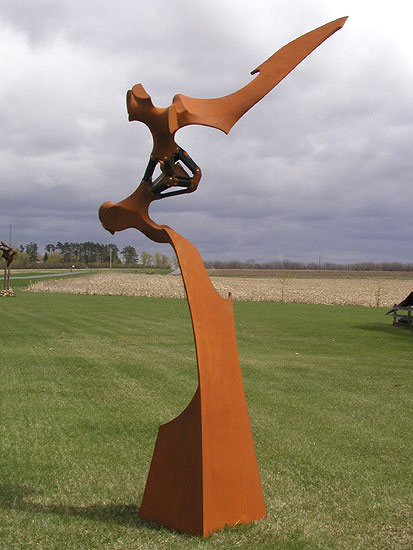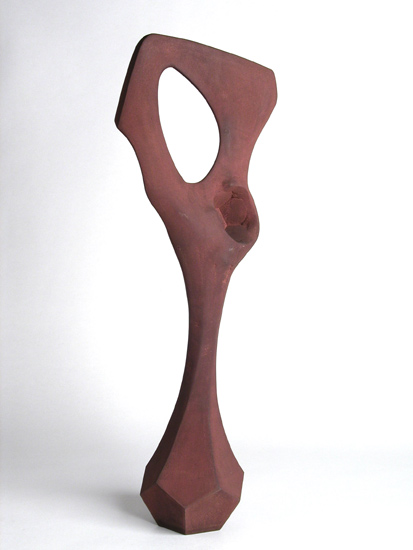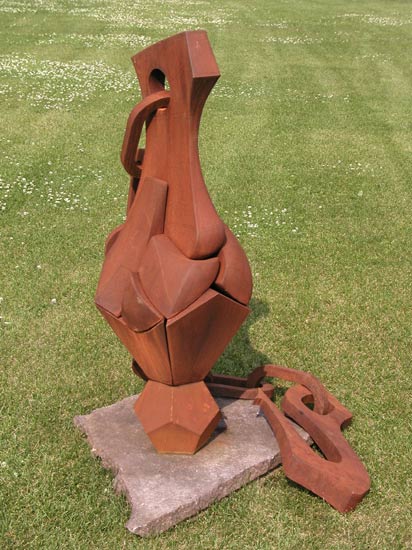Artists on Artists: We Were the Land’s Before It Was Ours
In the first of an occasional series of artists' writings about their own careers or those of others, Sam Spiczka describes his journey into sculpture. For more by Sam, explore the forums on this site.




Growing up in rural Minnesota, I experienced, however remotely, the early break in human nature: what happened when hunters and gatherers settled down to farm the earth. To this day, the shift seems to permeate the very ground. These two orientations toward life are often thought to be similar, but they are, in fact, radically different. They pull at each other. One impulse contradicts the other. One integrates itself into and becomes a part of nature. The other seeks to alter and control nature, rising above the given and using nature’s resources in novel ways.
So it happened that the hunter gave way to the farmer. The Paleolithic became the Neolithic. The peripatetic settled down and took root. Though now we may travel and move with relative frequency, we remain attached to a place on a day-to-day basis. Seasons pass and still we remain, divorcing ourselves from them. But the primal urge to engage nature, to integrate oneself with nature, is a basic force not so simply erased.
Through my sculpture, I discovered that this conflict had become a part of me. Perhaps the battle had existed long before I was born. Each time I wandered through a field, walking along furrows cut into the earth, I wasn’t walking alone. Every time I cut a path through the woods or traced the routes of rabbits, I wasn’t scouting alone. I was living out a conflict millenniums old, and it still felt undecided.
The hunter is a keen observer of life, a participant and a wanderer. In order to capture the animal, he must think like the animal. The hunter does not sit on top of Nature; he is simply one aspect of it. He does not dominate, he participates. And when he has taken his prey, he gives thanks to that beast for giving its life up for his own. The animal itself is a god. And man, because he too is an animal, is also a god.
The farmer is a rationalizer of nature, a creator of his world. He divides the land and cultivates it. In his hands, it becomes something different than it was. Remaining in one place, he re-creates Nature according to his image. To make his harvest dependable, he simplifies and alters. He breeds new types of grain, new types of animals. He too is a god, but a god of his own making. He captures the world, and the fences he erects in turn capture him.
As parts of the human race make the transition into a future cyber-reality, this conflict may seem primitive and irrelevant. But perhaps it is a special quality of Americans to believe that we can re-invent ourselves; that evolutions that once took thousands of years can today be accomplished in a generation. But of course this is not the case. As we enter the 21st century, we are in fact nearly identical to humans of a thousand years ago. In that case, such a “primitive” conflict as I experienced growing up, and since then in my work, is relevant.
For a long time, I could not explain the different strains in my sculptures. The works I create can be broken down into a few radically different types, seemingly unrelated to one another. One part of me creates oversized steel flower-like traps and bone forms that could be relics of animals long extinct. As a child, I would spend my time in the woods playing at setting rusty leg traps to catch rabbits. I was never successful at it.
The forest contained many treasures, but I did not have the skills to unlock them. In my juvenile enthusiasm, I could do little more than damage everything I touched. Looking at the sculpture American Lotus, I see that impotence and danger made physical. Like those woods, the sculpture is beautiful in its complexity and design. It undoubtedly has a purpose, and the viewer seeks to inspect it closer to unlock the mystery. But only when it is too late will you understand that you had no right going so close.
Another part of me creates geometric and organic fusions: sculptures that invoke seed forms and otherworldly growths. Picking rock or just traversing the uneven terrain of the plowed fields, it is amazing what you can find. Agates, glacially worn round rocks, broken bones, are just a few of the durable forms the ground throws up. In Fractured Daemon, I see a flower that has sprouted from such disparate “seeds” and taken root in the black earth. Here, I am a farmer myself, but the work is rooted in an imaginary distant past. Corn and wheat don’t interest me, but what if those rocks, bones, and fossils could be planted? What could they become?
At other times, hybrid, transitional forms emerge as if distinctions had become fluid and are no longer operable; differences break down and the walls between opposites crumble. In Regret, a geometric dodecahedron begins like a seed, splitting and replicating as it grows. But as the form rises, it solidifies into a single, pierced stalk. From there, a massive chain continues that replication in its links until finally a primitive, violent hook stands ready. Is it prepared to kill or simply to anchor? In these moments, my work seems to attempt an abstract, uneasy fusion of this primal conflict.
Looking over what I’ve created, I begin to understand that no single approach is sufficient. Though I may try, I simply cannot limit myself to a single style because I believe these conflicts are increasingly relevant as we move forward. The world we live in and the world we’ve left behind continue to inform our every action. These contradictory forms are needed to make palpable the space that lies between them. Only in the presence of all three can I feel the conflict inherent in the land made physical.